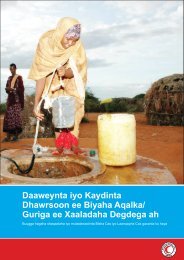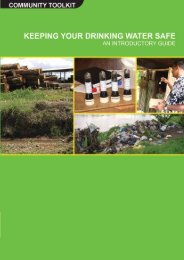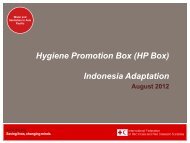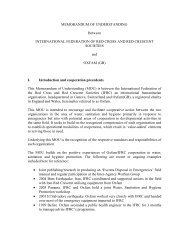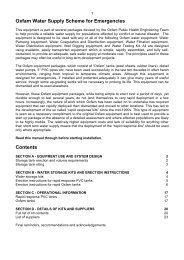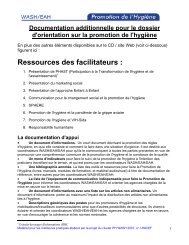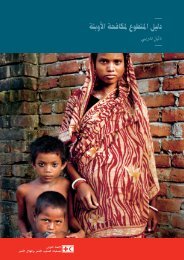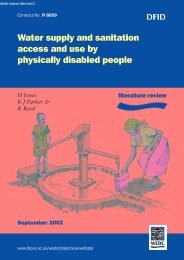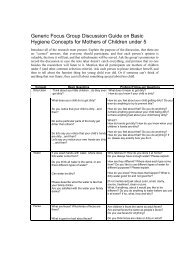Hygiene Promotion - IRC International Water and Sanitation Centre
Hygiene Promotion - IRC International Water and Sanitation Centre
Hygiene Promotion - IRC International Water and Sanitation Centre
You also want an ePaper? Increase the reach of your titles
YUMPU automatically turns print PDFs into web optimized ePapers that Google loves.
A household <strong>and</strong>/or school hygiene self-surveyA survey is planned <strong>and</strong> implemented by a team of local women <strong>and</strong> men inhabitants orparents, teachers <strong>and</strong> students helped by a local health or NGO worker.Lists <strong>and</strong> tables (matrices)Another technique is to list households which for example have <strong>and</strong> do not have certainimproved water supply, sanitation or hygiene facilities. The number of households with <strong>and</strong>without facilities are then noted in a large table for all these facilities. Numbers may bewritten as figures, but non-literate or mixed groups usually use markings (e.g. tally marks),matchsticks, beans or pebbles. The table is sometimes adjusted for poverty (see Box). Thegroup analysis the findings (“who are haves <strong>and</strong> have nots <strong>and</strong> why?”). They also makeplans for improvements. They set priorities, decide on strategies, analyse human <strong>and</strong>financial recourses, make plans, list activities to implement the plans, identify women <strong>and</strong>men to carry out these activities, divide tasks, based on skills <strong>and</strong> workloads, makeworkplans <strong>and</strong> start implementation. For all these activities, other participatorytools/techniques are available.All these approaches are based on a wealth of experiences in working with communities<strong>and</strong> households. There is a wide range of techniques that ensure involvement of groupswho may otherwise be excluded, including, as just a few examples:• PLA Notes, a periodical published by the <strong>International</strong> Institute for Environment <strong>and</strong>Development (IIED) has regular features about tools for PLA (Participatory Learning<strong>and</strong> Action) in a range of different situations. One issue is devoted to PLA inCommunity <strong>Water</strong> Management (http://www.irc.nl/page/1866)• A very interesting specific example of a methodology for increasing awareness ofhygiene issues in a participatory way is described in the Case Studies. Zimbabwe’s“Health Clubs” give free courses on health <strong>and</strong> hygiene issues to anyone wishing toattend. They generate commitment <strong>and</strong> spread awareness of critical risks, resulting inmeasurable improvements in hygiene behaviours.• The NORWASP project in Ghana uses a “Health <strong>and</strong> <strong>Hygiene</strong> Game” to stimulateawareness.• <strong>IRC</strong>’s Technical Paper 29 (Just Stir Gently, see References) includes a table (page106) giving the pros <strong>and</strong> cons of different visual tools that can be prepared in advancefor facilitating community group discussions.86 <strong>Hygiene</strong> promotion



